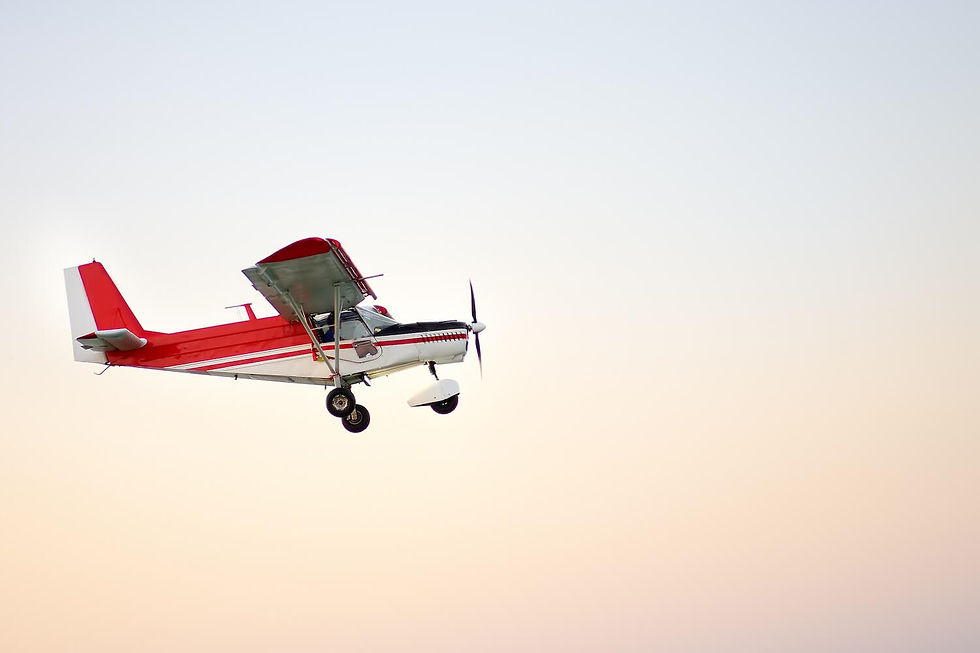The Art of Staying Calm as a Pilot
- Mike Kloch

- Nov 11
- 3 min read
Updated: Dec 2

In aviation, calm isn’t just a virtue — it’s a vital skill. Whether you’re flying a fighter jet, a
private aircraft, or training in a Cessna 172, your ability to stay composed directly affects safety,
decision-making, and crew confidence. Pilots are trained, to varying degrees, to manage complex
systems and unexpected challenges, but it’s the calm mindset that keeps all those skills effective when it matters most.
Confidence comes from Pilot competence.
The more thoroughly a pilot understands their aircraft,
procedures, and environment, the less room there is for panic. Before takeoff, a professional
mindset starts with:
Detailed preflight checks
Weather and NOTAM reviews
Mental rehearsals of “what-if” scenarios
Training for difficult scenarios
Learning to deal with surprise and startle
Preparation doesn’t eliminate all surprises, but it transforms them into manageable problems
rather than emergencies.
Remember your first simulated engine failure? — the jolt of adrenaline, the racing thoughts.
Over time, that reaction changes. Training turns chaos into choreography.
By practicing procedures repeatedly, pilots build what’s often called muscle memory. When a
system warning light flashes or turbulence hits, instinct takes over, guided by practiced
checklists and calm logic. The key is to trust that training — and resist the urge to improvise
under stress.
Calm isn’t the absence of fear; it’s the management of it. Pilots must learn to control their inner
dialogue during high-stress moments. Instead of thinking “This is bad,” focus on “What’s
next?” My experience with providing Upset Prevention and Recovery Training (UPRT) has
shown that many pilots need to work on the art of staying calm. Not remaining calm results in
several problems, such as acting too quickly (skipping analysis of the situation), overcontrolling,
fixation, reduction of situational awareness, poor judgment, freezing up, and more. All-attitude
flying definitely gets a pilot’s attention, but it’s not the only situation that will do so. As pilots, we
have to learn to deal with anything that may happen.
Techniques like controlled breathing, positive affirmations, or focusing on a single immediate
task (without fixation) can reset the body’s stress response and keep thinking clearly. One should
also learn to be confident and work the problem at hand. This is all easier said than done.
Training and learning to control one’s mind are crucial to success.
There are many ways to train for improved mental control. Difficult simulator scenarios are
great. Piling on things such as system emergencies, weather, flight control issues, etc., makes a
pilot work hard and creates stress. The military and airlines are great at this. Creating aircraft
problems in a simulator makes for excellent training. UPRT is fantastic for stress inoculation.
Being upside down is disorienting and stressful at first. Once trained, it becomes much less of an
issue. It significantly enhances one's confidence.
In aviation, communication equals calm. A composed voice on the radio reassures not just ATC,
but also passengers and crew. Clear, concise communication cuts through confusion — and even
helps regulate your own emotions. Whether declaring an emergency or coordinating with a co-
pilot, professionalism in tone and wording keeps everyone aligned and grounded. Even routine
flights hold lessons. Reflecting on what went smoothly — and what didn’t — sharpens your
responses for next time. Calmness isn’t a one-time achievement; it’s built over thousands of
quiet decisions and honest self-assessments.
Your demeanor shapes the cockpit atmosphere. Calm is contagious. If the pilot in command
manages a sudden problem with a measured voice and steady hands, the rest of the crew (and
even the passengers) follow suit. Leadership, in the air, begins with emotional steadiness.
Instructors need to remain calm at all times. If I say “oh [darn]/[shoot]/[crap]” out loud, the pilot
in training immediately asks what’s going on, and likely will get nervous. Even though it may
have been nothing serious, it conveys the wrong message. I assure nervous customers of my
experience to help them feel confident about our flights. “If I am not afraid, why are you?” I am
the safety net for training. Not all instructors are able to make such a statement, but it’s an
example of trying to help pilots in training learn to remain calm in a stressful training scenario.
Staying calm as a pilot is about preparation, trust, and mindset. It’s about turning stress into
structure and pressure into performance. The best aviators don’t just fly planes — they fly
attitudes. “Attitude is everything”, is another phrase I love to use. The proper attitude will
improve your flying and your life in general!
When the unexpected happens, good pilots don’t freeze or flinch. They breathe, assess, act, and keep flying the airplane.
Because in the sky, calm isn’t just part of the job.
It is the job.
Mike “Cuckoo” Kloch




Comments